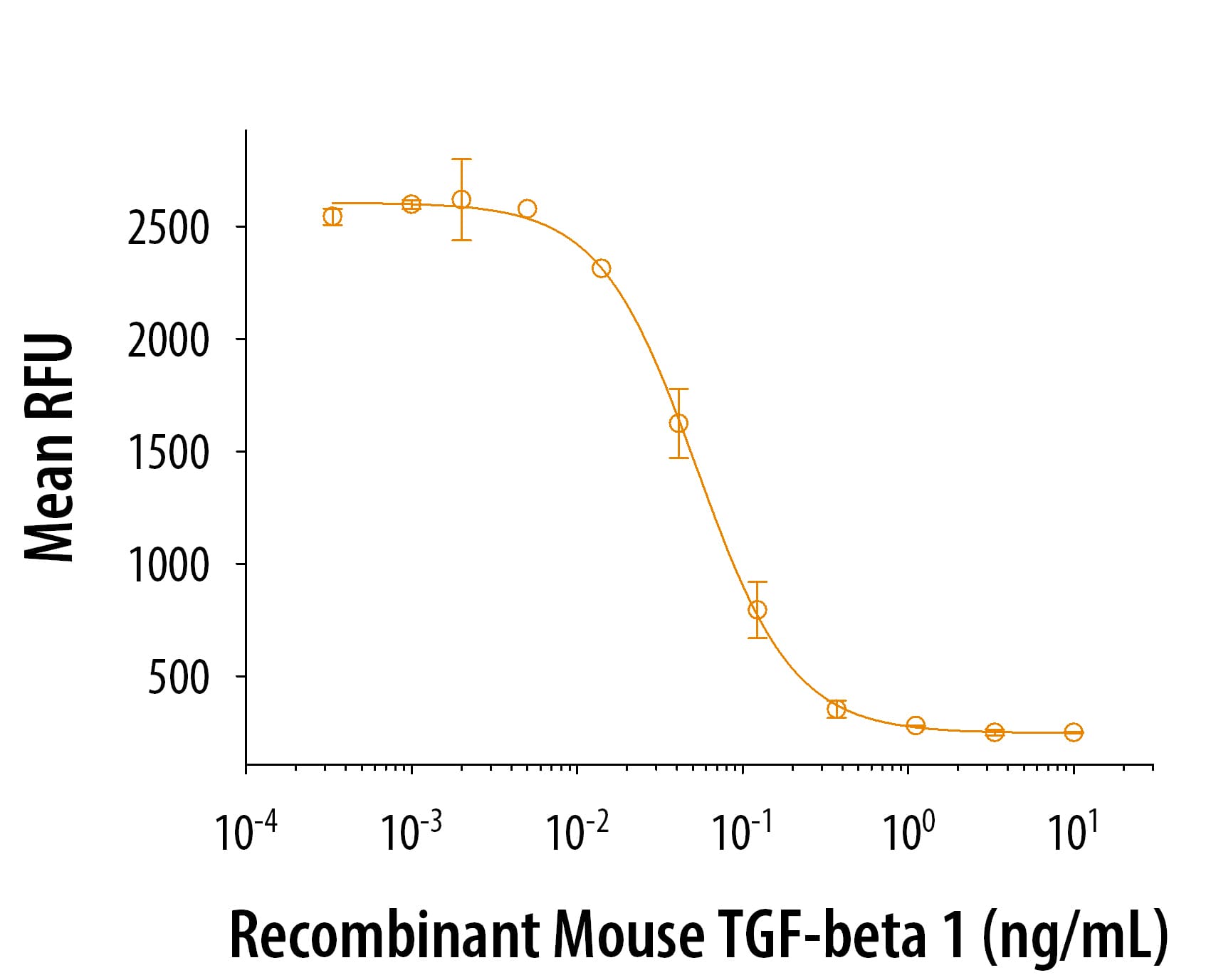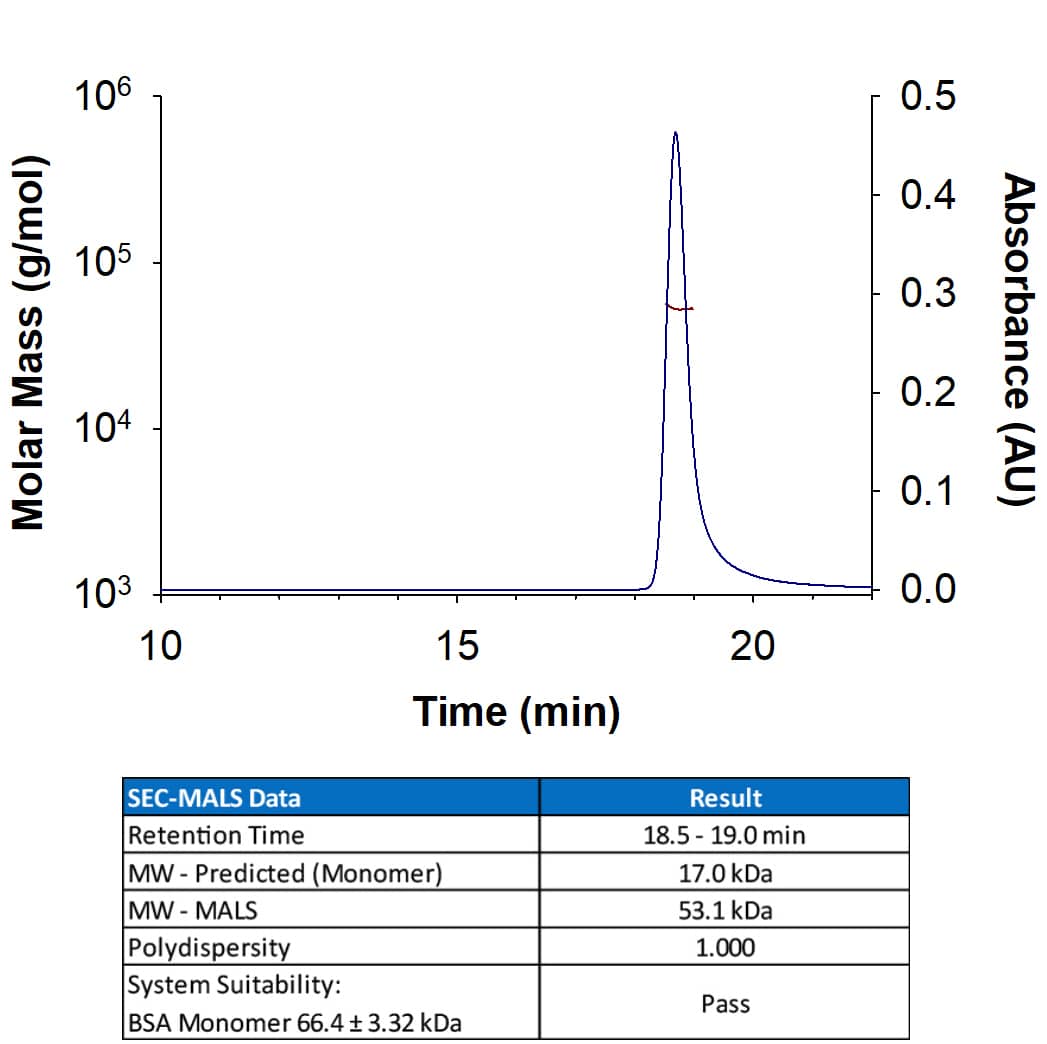Mouse Ephrin-B1 Biotinylated Antibody Summary
Lys30-Ser229
Accession # AAA53231
Customers also Viewed
Applications
Please Note: Optimal dilutions should be determined by each laboratory for each application. General Protocols are available in the Technical Information section on our website.
Preparation and Storage
- 12 months from date of receipt, -20 to -70 °C as supplied.
- 1 month, 2 to 8 °C under sterile conditions after reconstitution.
- 6 months, -20 to -70 °C under sterile conditions after reconstitution.
Background: Ephrin-B1
Ephrin-B1, also known as LERK-2, ELK-L, EFL-3, Cek5-L, and STRA-1 (1), is a member of the ephrin ligand family which binds members of the Eph receptor family. All ligands share a conserved extracellular sequence, which most likely corresponds to the receptor binding domain. This conserved sequence consists of approximately 125 amino acids and includes four invariant cysteines. The B-class ligands are transmembrane proteins which can become tyrosine phosphorylated upon receptor ligation. The cytoplasmic domains are approximately 80 amino acids long and are highly conserved, especially the last 33 amino acids. Several signaling molecules have been shown to interact with the cytoplasmic region, although specific signaling roles have yet to be elucidated. Ephrin-B1 has been shown to bind EphA3, EphB1, EphB2, EphB3, and EphB4 (2, 3). The extracellular domains of human and mouse Ephrin-B1 share 94% amino acid identity. Only membrane-bound or Fc-clustered ligands are capable of activating the receptor in vitro. Soluble monomeric ligands bind the receptor but do not induce receptor autophosphorylation and activation (2). In vivo, the ligands and receptors display reciprocal expression (3). It has been found that nearly all receptors and ligands are expressed in developing and adult neural tissue (3). The Eph/ephrin families also appear to play a role in angiogenesis (3).
- Eph Nomenclature Committee [letter] (1997) Cell 90:403.
- Flanagan, J.G. and P. Vanderhaeghen (1998) Annu. Rev. Neurosci. 21:309.
- Pasquale, E.B. (1997) Curr. Opin. Cell Biol. 9:608.
Product Datasheets
Citations for Mouse Ephrin-B1 Biotinylated Antibody
R&D Systems personnel manually curate a database that contains references using R&D Systems products. The data collected includes not only links to publications in PubMed, but also provides information about sample types, species, and experimental conditions.
12
Citations: Showing 1 - 10
Filter your results:
Filter by:
-
Germinal Center B Cells Replace Their Antigen Receptors in Dark Zones and Fail Light Zone Entry when Immunoglobulin Gene Mutations are Damaging
Authors: Isabelle Stewart, Daniel Radtke, Bethan Phillips, Simon J. McGowan, Oliver Bannard
Immunity
-
TBL1XR1 Mutations Drive Extranodal Lymphoma by Inducing a Pro-tumorigenic Memory Fate.
Authors: Leandro V, Matt T, Andrew Z et al.
Cell.
-
Activated Peyer′s patch B cells sample antigen directly from M cells in the subepithelial dome
Authors: Rathan Joy Komban, Anneli Strömberg, Adi Biram, Jakob Cervin, Cristina Lebrero-Fernández, Neil Mabbott et al.
Nature Communications
-
STAT3 signaling in B cells controls germinal center zone organization and recycling
Authors: Adam J. Fike, Sathi Babu Chodisetti, Nathaniel E. Wright, Kristen N. Bricker, Phillip P. Domeier, Mark Maienschein-Cline et al.
Cell Reports
-
The Eph-related tyrosine kinase ligand Ephrin-B1 marks germinal center and memory precursor B cells
Authors: Brian J. Laidlaw, Timothy H. Schmidt, Jesse A. Green, Christopher D.C. Allen, Takaharu Okada, Jason G. Cyster
Journal of Experimental Medicine
-
STAT3 signaling in B cells controls germinal center zone organization and recycling
Authors: Adam J. Fike, Sathi Babu Chodisetti, Nathaniel E. Wright, Kristen N. Bricker, Phillip P. Domeier, Mark Maienschein-Cline et al.
Cell Reports
Species: Transgenic Mouse
Sample Types: Whole Cells
Applications: Flow Cytometry -
DNA dioxygenases Tet2/3 regulate gene promoter accessibility and chromatin topology in lineage-specific loci to control epithelial differentiation
Authors: GD Chen, I Fatima, Q Xu, E Rozhkova, MY Fessing, AN Mardaryev, AA Sharov, GL Xu, VA Botchkarev
Science Advances, 2023-01-11;9(2):eabo7605.
Species: Mouse
Sample Types: Whole Cells
Applications: Flow Cytometry -
TBL1XR1 Mutations Drive Extranodal Lymphoma by Inducing a Pro-tumorigenic Memory Fate.
Authors: Leandro V, Matt T, Andrew Z et al.
Cell.
-
The transcription factor Hhex cooperates with the corepressor Tle3 to promote memory B cell development
Authors: BJ Laidlaw, L Duan, Y Xu, SE Vazquez, JG Cyster
Nat. Immunol., 2020-06-29;0(0):.
Species: Mouse
Sample Types: Cell Lysates
Applications: Flow Cytometry -
Binding of ras to phosphoinositide 3-kinase p110alpha is required for ras-driven tumorigenesis in mice.
Authors: Gupta S, Ramjaun AR, Haiko P, Wang Y, Warne PH, Nicke B, Nye E, Stamp G, Alitalo K, Downward J
Cell, 2007-06-01;129(5):957-68.
Species: Mouse
Sample Types: Whole Tissue
Applications: IHC-Fr -
Development of Tbet- and CD11c-expressing B cells in a viral infection requires T follicular helper cells outside of germinal centers
Authors: Wenzhi Song, Olivia Q. Antao, Emily Condiff, Gina M. Sanchez, Irene Chernova, Krzysztof Zembrzuski et al.
Immunity
-
Affinity-restricted memory B cells dominate recall responses to heterologous flaviviruses.
Authors: Rachel Wong, Julia A. Belk, Jennifer Govero, Jennifer L. Uhrlaub, Dakota Reinartz, Haiyan Zhao et al.
Immunity
FAQs
No product specific FAQs exist for this product, however you may
View all Antibody FAQsIsotype Controls
Reconstitution Buffers
Staining Reagents
Supplemental Cell Selection Products
Supplemental ELISA Products
Reviews for Mouse Ephrin-B1 Biotinylated Antibody
There are currently no reviews for this product. Be the first to review Mouse Ephrin-B1 Biotinylated Antibody and earn rewards!
Have you used Mouse Ephrin-B1 Biotinylated Antibody?
Submit a review and receive an Amazon gift card.
$25/€18/£15/$25CAN/¥75 Yuan/¥2500 Yen for a review with an image
$10/€7/£6/$10 CAD/¥70 Yuan/¥1110 Yen for a review without an image













